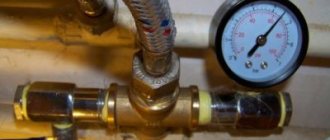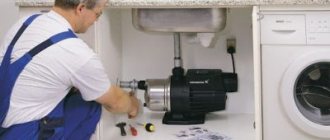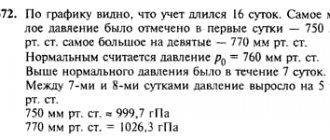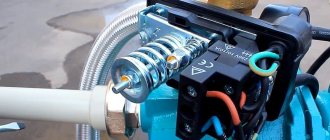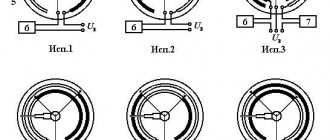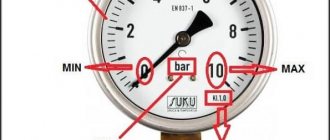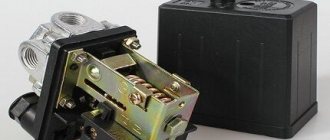Liquid pressure gauge
The open liquid manometer device is a two-legged glass tube filled with liquid. Since only atmospheric pressure acts on the surface of the liquid, the liquid is established at the same level.
A rubber tube is attached to one end of the glass tube and connected to a flat box covered with rubber film. What happens if we press our finger on the film? Figure 2 shows that the liquid level in the pressure gauge elbow, which is connected to the rubber tube, will decrease.
Figure 2. Open liquid pressure gauge.
Let's remember Pascal's law: the pressure exerted on a liquid or gas is transmitted to any point without changes in all directions. This means that when we pressed the film, we increased the air pressure in the box.
Since the box is connected to the elbow of the glass tube, pressure is transferred to the liquid in this elbow (let’s call it “first”), that is, the pressure in the first elbow will be greater than the pressure in the other, because only atmospheric air pressure acts on that elbow.
The liquid will come to equilibrium and stop when the excess pressure in the first bend equals the pressure of the excess liquid column in the other.
The pressure exerted on the film will depend on the force of pressing: the harder we press, the higher the excess column of liquid will be. This means that the change in pressure can be associated with the height of this excess column.
With the help of a liquid pressure gauge we can measure pressure in liquids. Pay attention to Figure 3.
Figure 3. Measuring fluid pressure using a fluid pressure gauge.
The design of the pressure gauge has not been changed, but we can immerse a box covered with film in a container of water. From experience it is clear that the deeper the box is, the greater the difference in height of the liquid in the pressure gauge elbows becomes . We can say that the more pressure the liquid produces in the container.
What if we turn the box in different directions at the same depth? And again, Pascal’s law will help us answer this question: the pressure gauge readings will not change, because the pressure in all directions at the same depth/height is the same.
Take a look at Figure 4. This is what a liquid pressure gauge looks like in real life.
Figure 4. Realistic image of a liquid pressure gauge.
Calculation instructions
The height difference between liquid levels is calculated by the formula:
h = (Rabs – Ratm)/((rzh – ratm)g) where: Rabs – absolute measured pressure. Ratm – atmospheric pressure. rzh – density of the working fluid. ratm – density of the surrounding atmosphere. g – gravitational acceleration (9.8 m/s2) The indicator of the height of the working fluid H consists of two components: 1. h1 – lowering of the column compared to the initial value. 2. h2 – increase in the column in another part of the tube compared to the initial level. The ratm indicator is often not taken into account in calculations, since rl >> ratm. Thus, the dependence can be represented as: h = Rizb/(rzh g) where: Rizb is the excess pressure of the measured medium. Based on the above formula, Rizb = hrж g.
If it is necessary to measure the pressure of discharged gases, measuring instruments are used in which one of the ends is hermetically sealed, and vacuum pressure is connected to the other using supply devices. The design is shown in the diagram:
Diagram of an absolute pressure liquid vacuum gauge
For such devices, the formula is used: h = (Ratm - Rabs)/(rzh g).
The pressure at the sealed end of the tube is zero. If there is air in it, calculations of vacuum gauge pressure are performed as follows: Ratm – Rabs = Rizb – hrzh g.
If the air in the sealed end is pumped out, and the counter pressure Ratm = 0, then: Rabs = hrz g.
Designs in which the air at the sealed end is evacuated and evacuated before filling are suitable for use as barometers. Recording the difference in column height in the sealed part allows for accurate calculations of barometric pressure.
Metal pressure gauge
You have already seen the appearance of a metal pressure gauge in Figure 1. Let us now consider its internal structure, which comes in two main types. The first is shown in Figure 5.
Figure 5. Design of metal pressure gauge No. 1.
A curved hollow tube 1, sealed at one end, is connected on the other side to a tap 4, which communicates with the vessel in which the pressure needs to be measured.
As the pressure increases, tube 1 begins to unbend, and with the help of lever mechanism 5 and gears 3 transmits movement to pointer 2, which moves along the scale of the device.
Tube 1 is elastic, and when the pressure decreases, it returns to its original position, and the pointer returns to the zero scale division.
Figure 6 shows a slightly different type of metal pressure gauge.
Figure 6. Design of metal pressure gauge No. 2.
The difference in structure is only that the tube is sealed on both sides, but has an outlet for connection to the vessel in which the pressure needs to be measured. There are also two rods (levers) 2.
Note that, despite slight differences in the device (Figures 4 and 6), the principle of operation of metal pressure gauges remains the same.
The actual appearance of the metal pressure gauge is shown in Figure 7.
Figure 7. Realistic image of a metal pressure gauge.
Advantages and disadvantages
Liquid pressure gauges have both strengths and weaknesses. When using them, it is possible to optimize capital and operating costs for control and measurement activities. At the same time, one should remember about the possible risks and vulnerabilities of such structures.
Key advantages of liquid-filled measuring instruments include:
- High measurement accuracy. Devices with a low level of error can be used as reference ones for checking various control and measuring equipment.
- Ease of use. The instructions for using the device are extremely simple and do not contain any complex or specific actions.
- Low cost. The price of liquid pressure gauges is significantly lower compared to other types of equipment.
- Quick installation. Connection to the target pipelines is made using supply devices. Installation/disassembly does not require special equipment.
When using liquid-filled pressure gauges, some weaknesses of such designs should be taken into account:
- A sudden increase in pressure can lead to the release of working fluid.
- The possibility of automatic recording and transmission of measurement results is not provided.
- The internal structure of liquid pressure gauges determines their increased fragility
- The devices are characterized by a fairly narrow measurement range.
- The correctness of measurements can be impaired by poor cleaning of the internal surfaces of the tubes.
Operating principle of the pressure gauge
A pressure gauge is a device for measuring excess pressure. Due to the fact that this value can be different, there are different types of devices.
The principle of operation of the pressure gauge is based on balancing the measured pressure by the force of elastic deformation of a tubular spring or a more sensitive two-plate membrane, one end of which is sealed in a holder, and the other is connected through a rod to a tribic-sector mechanism that converts the linear movement of the elastic sensing element into a circular movement of the indicating arrow.
Types of pressure gauges
Pressure measuring instruments vary depending on the design:
- Liquid.
- Membrane.
- Spring.
- Differential.
Modern types of devices are divided into 7 large groups depending on operating conditions:
- Exemplary. Instruments with very high measurement accuracy . They are used to check the accuracy of the readings of other similar measuring equipment, that is, verification.
- Electric contact. Special devices for monitoring and warning about reaching the maximum permissible parameter that can destroy the system. To do this, a valve is built in that relieves the pressure to a safe level. As a result, safe work is ensured in enterprises and boiler houses.
- General technical. These are resistant to vibrations and low temperatures, therefore they are used in transport and pipelines.
- Self-recording. They allow you not only to visually observe the readings, but also to record them on a special diagram in order to track the dynamics of changes in a parameter over a certain period of time. Such devices are indispensable in research laboratories, thermal power plants, and many enterprises.
- Special. Designed to work with various harmful and dangerous gases, for example, ammonia, acetylene, argon, methane. They differ from other devices in the color of the body or the ring that presses the glass.
- Railway . Such devices have increased resistance to vibration, thanks to the viscous liquid inside the case, for example, glycerin or silicone oil.
- Ship's. They have a body protected from the influence of precipitation and are not subject to corrosion.
There are devices with special characteristics: signaling, vibration-resistant, corrosion-resistant.
Types and design of the device
- Frame.
- Instrument arrows.
- Gears.
- Axis.
- Leash.
- Gear sector.
A special spring is installed between the teeth of the sector and the gear, which is necessary in order to eliminate backlash.
The measuring scale is presented in Bars or Pascals. The arrow shows the excess pressure of the medium in which the measurement is being taken.
The principle of operation is very simple.
The pressure from the medium being measured enters the tube.
Under its influence, the tube tries to level out, since the area of the outer and inner surfaces has different sizes.
The free end of the tube moves, and the arrow rotates at a certain angle thanks to a transmission mechanism.
The measured value and the tube deformation are in a linear relationship.
That is why the value that the arrow shows is the pressure of a certain environment.
According to their purpose, pressure gauges are of the following types:
- Self-recording. They contain a mechanism that allows you to draw a graph of the device’s operation on paper.
- Railway. Used in railway transport.
- Ship's. Used on sea and river vessels.
- Reference. They have a high accuracy class. That is why they are used for testing, adjusting and checking other pressure measuring instruments.
- Special. Used to measure the value of various gases. Depending on what gas they are intended for, they have different body colors and marking letters: for measuring flammable gases - red, for non-flammable gases - black, yellow ammonia (A), white acetylene (Ac), blue oxygen (K).
- Electric contact. They have an electrical alarm that allows you to regulate the measured environment. These devices are divided into two types: based on an electrical contact attachment and with microswitches.
- General technical. Designed to measure pressure in various environments. They can measure excess and vacuum pressures.
Based on the principle of operation, the following types are distinguished:
- Piezoelectric. Based on the piezoelectric effect. A charge appears in a quartz crystal under mechanical action.
- Deformation. They are based on the deformation of the sensitive element (membrane, bellows, spring, etc.), which, when deformed, acts on the pointer.
- Liquid. Their basis is a tube filled with liquid. They can be of two types: with one or two tubes. Devices with two tubes are used to compare pressure in different environments.
- Piston. They consist of a cylinder with a piston inserted inside.
Liquid measurement systems
The value in these pressure gauges is measured by balancing the weight of the liquid column. A measure of pressure is the level of fluid in communicating vessels. These devices can measure values in the range of 10−105 Pa. They have found their application in laboratory conditions.
Essentially, it is a U-shaped tube containing a liquid with a higher specific gravity compared to the liquid in which the hydrostatic pressure is directly measured. This liquid is most often mercury.
Pressure gauge tap. Device
The device is attached to the pipeline using a multifunctional three-way valve.
Depending on the position of the locking mechanism handle, the operation of the measuring device is controlled. The body contains a plug with a T-shaped hole. By turning the handle to operating mode, the flow is directed to the pressure gauge, which records the pressure. If you turn the valve to the “closed” position, the flow in the pipe will stop or change direction. The device will show zero value.
Thus, the tap is necessary for purging, checking the device and completely disconnecting the measuring device, for example, to replace it.
Devices that measure pressure, despite the same principle of operation, are used for different operating conditions and have different designs. Some show the amount of liquid pressure, while others work only with gas. Some of them are used in instrumentation to determine accurate pressure readings. Often pressure gauges are part of automation and alarm units and provide safe working conditions in enterprises.
provides a wide range of different types of valves. Shut-off valves at the best prices!
How to check water pressure in a tap without a pressure gauge
To check the water pressure in a water supply system without a pressure gauge, you will need to independently build a “liquid pressure gauge” from a hose. To do this, follow these steps:
- take a transparent hose, the length of which should be 2 m;
- fix it in a vertical position;
- open the tap and fill the hose with water to the zero level (corresponding to the bottom of the tap);
- Close the other end of the hose tightly.
Next, you need to record some indicators - the length from the zero level to the end closed with a plug, the length of the tube between the level of liquid under pressure and the closed end of the hose. The following formula is used for calculation.
There are several other ways to measure pressure in a water supply system, but they are all approximate and rather inaccurate. Thanks to a huge assortment, today you can purchase an inexpensive and high-quality pressure gauge that can be easily installed even without the help of specialists. And constant pressure monitoring will allow you to monitor the operation of pumping, cleaning and other water supply equipment.
